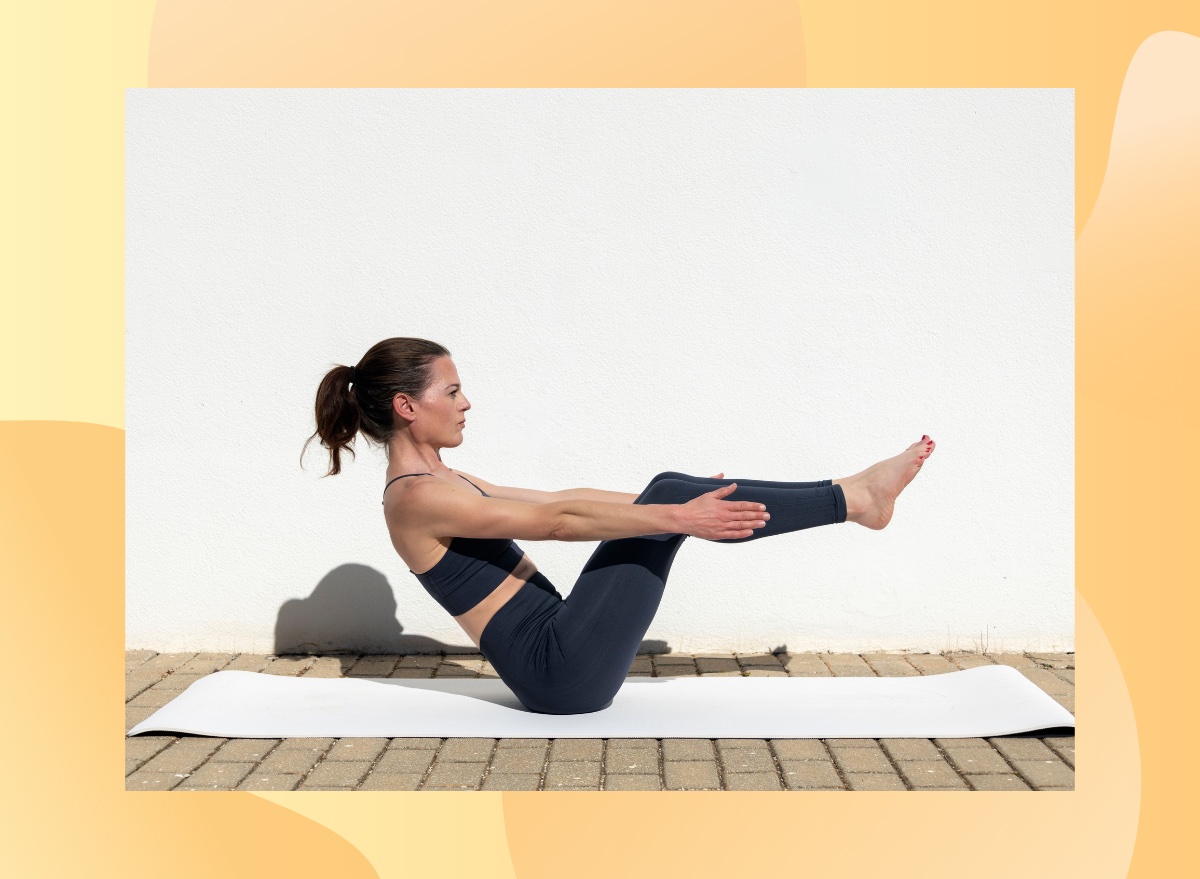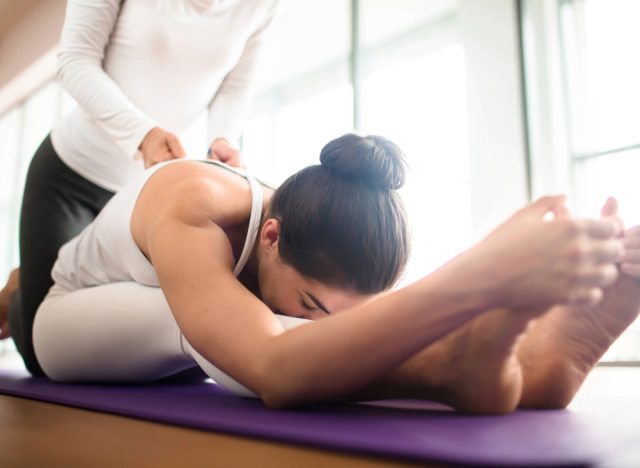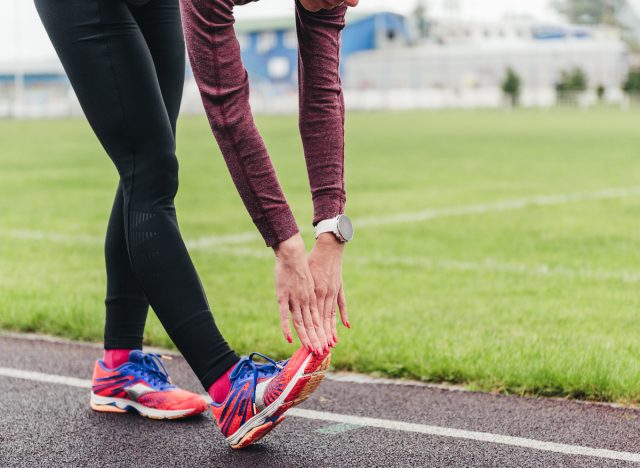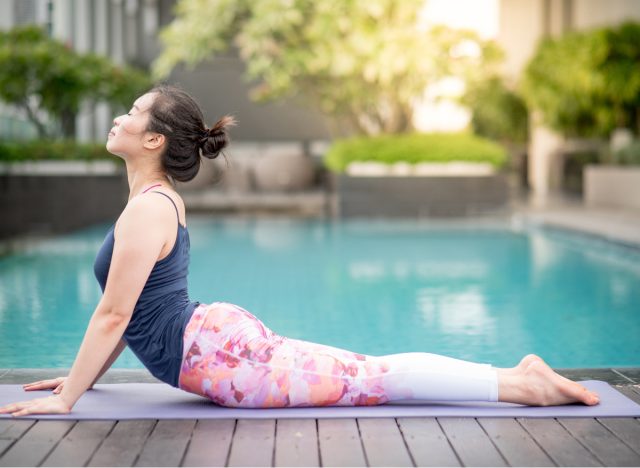Fitness
Adult exercisers’ attitudes toward female and male personal fitness trainers: Influence of gender, age, and exercise experience

Authors: Edward P. Hebert1, and Jada McGuin2
1Department of Kinesiology and Health Studies, Southeastern Louisiana University, Hammond, LA, USA
2Fitt House, Baton Rouge, LA, USA
Corresponding Author:
Edward Hebert
SLU Box 10845
Hammond, LA 70810
ehebert@selu.edu
985-549-2132
Edward Hebert, PhD is a Professor of Kinesiology at Southeastern Louisiana University. His research interests include exercise motivation and adherence, and applied research in motor learning.
Jada McGuin, MS is a fitness professional and the Owner/Operator of The Fitt House in Baton Rouge.
An examination of studies related to Brazilian jiu-jitsu in enhancing mental and physical health among veterans and first responders: A scoping review
ABSTRACT
This study describes attitudes of adult exercisers toward female and male personal fitness trainers, and compares responses of male and female, younger vs older exercisers, and those with varying levels of exercise experience. Recruited from 4 fitness gyms, 201 adults aged 18 to 77 completed an anonymous survey where they provided relative attitude ratings toward female vs. male fitness trainers specific to the trainer’s knowledge, helping meet personal fitness goals, following their directions, comfort discussing struggles with exercise, working with the trainer for an extended time, and referring others to them. Participants rated male trainers higher for fitness knowledge, and were more willing to follow their directions, work with them for an extended time, and refer clients to them, but perceived a female trainer more favorably for discussing their struggles with exercise. Significant gender, age, and experience differences were found. Gender-biased perceptions were highest among male, older, and inexperienced exercisers, who had more positive attitudes toward male fitness trainers. Attitudes of women, younger, and experienced exercisers tended to be more neutral, and favor female trainers for meeting personal goals and discussing struggles. The results of this exploratory study suggest gender-biased exercise attitudes are influenced by participant gender, as well as age and experience, and provide impetus for additional research on exercise attitudes.
Keywords: personal training, beliefs, perceptions, biases
INTRODUCTION
Recent decades have seen a great expansion of the fitness industry signaled by an increase in the number of adults exercising in fitness centers around the world. This rise has been attributed to a number of factors including global recognition of the benefits of physical activity, endorsement of exercise by the medical community, and growth of the fitness industry (1, 23). Yet, exercise adherence remains problematic (30, 32) and fitness clubs tend to have low retention rates (23). The practice of exercising with a personal fitness trainer (PFT) has increased in popularity and personal training has become a standard feature in many settings (5, 21, 23, 33). PFTs design and supervise exercise programs, and help clients set and reach personal goals. In addition, they engage in practices to promote an active lifestyle, motivate clients, and facilitate their exercise competence and self-efficacy, which can play an important role in exercise adherence (23, 29, 33). Studies of consumers consistently identify a fitness club’s staff, and fitness leaders’ instruction, feedback, and support as among the most important factors in customer satisfaction (15, 27). In addition, satisfaction with individualized training is positively associated with exercise motivation and self-efficacy (33). Consistent evidence points to the benefits of exercising with a PFT. Studies show that individuals who train with a PFT are more likely to attend exercise sessions and adhere to programs (2, 12, 18, 26). Those who train with a PFT have been found to exercise at higher intensities (25, 31) and make greater strength and fitness gains (24, 25) than those who exercise independently. These results are similar to findings comparing individuals who train alone vs. under the supervision of a fitness professional (9, 14).
Studies of fitness settings have often concluded that gender plays a role in gym-related attitudes and behaviors. In their review, Håman et al. (16) suggested fitness gym spaces are strongly associated with male bodies and norms, and gender norms influence social practices and behaviors there. Exercise motivation has been tied to weight loss for women and enhancing muscularity among men (20). Certain types of exercise are considered masculine or feminine, and exercisers have been shown to use gendered language to refer to areas of the gym (7). Interview-based studies of PFTs indicate that a clients’ gender influences their advice (16) and they recognize that gender plays a role in clients’ selection of a trainer (29).
The results of previous interview-based studies (21, 28) indicated that women prefer a female PFT. This preference is based on perceptions of being less self-conscious about their bodies with a female trainer, and the beliefs that a female trainer would better understand and empathize with their struggles with exercise and comfort levels in the gym. Survey-based research comparing perceptions of male and female fitness trainers have studied the attitudes of college students, and produced mixed results. In their study of 402 undergraduates, Fisher et al. (13) found no clear preference for a male or female PFT, yet hypothetical female PFTs received higher ratings for general perceptions of competence, and participants’ willingness to discuss progress and take instructions/corrections from them, compared to male trainers. Boerner et al. (5) similarly found that college undergraduates perceived female PFTs as more competent and knowledgeable than males. However, male students preferred to work with a male fitness trainer, while female students had no gender preference. Similarly, Magnusen and Rhea (22) found female college Division I athletes had no preference for a male or female strength coach, whereas males preferred a male coach.
Thus, research to date on attitudes toward male vs. female PFTs has provided mixed results, and survey-based studies to date have exclusively examined perceptions of college students, which may be different from non-college aged adults. In addition, research has yet to examine how attitudes toward male/female fitness trainers may vary with other potentially-influential factors such as age and exercise experience. Thus, the purpose of this exploratory study was to examine attitudes toward male and female PFTs in a sample of adult members of fitness gyms, and compare responses with respect to participant gender, age, and exercise experience.
METHODS
Participants
Participants were 201 (144 female; 57 male) adult members of four fitness centers from one city in the southeast United States who responded to an online survey. They ranged in age from 18 to 77 years (mean = 35.87, SD = 14.87 years). Self-reported experience levels were Beginner (n=59), Intermediate (n=91) and Advanced (n=51). Over half of the sample indicated exercising four or more times per week (54.9%), with 25.3% indicating three times per week, and 20.1% once a week. Table 1 provides the number and percent of male and female participants in age and exercise experience groups.

Procedures
Prior to data collection, the study was approved by the Institutional Review Board of the authors’ university. Participants were recruited from fitness centers via email with the cooperation of the managers. Two facilities were small gyms that offered only individual and small group training, and two were larger traditional fitness centers that housed a variety of equipment and amenities, and provided personal training services and group exercise classes as well as independent exercise. A recruiting email with a link to an anonymous online survey was sent to all members of the two small gyms, and members of the larger gyms who had expressed interest in personal training. Participants were assured of anonymity and informed their participation was voluntary and they were providing consent to participate by completing the survey.
Data were collected using a survey created for the study. Survey items were based on and relatively similar to those used in previous research on attitudes toward female/male fitness trainers (13). Item content was guided by previous research examining criteria for selecting a PFT (16, 23, 29) and on reasons people may prefer a male/female PFT (21, 28). After initial development, the survey was reviewed by researchers with expertise in fitness who provided feedback and recommendations.
The first section sought demographic information including gender, age, level of fitness experience (beginner, intermediate, or advanced), and frequency of exercise during the last month. The next section focused on participant’s attitudes about working with a PFT, specifically how their attitudes would be influenced by the trainer’s gender. It included 6 face-valid items: (1) “My belief about the trainer’s knowledge about fitness,” (2) “My belief in the trainer’s desire for me to meet my personal fitness goals,” (3) “My willingness to follow the trainer’s directions about exercise,” (4) “My level of comfort discussing my struggles with exercise with the trainer,” (5) “My willingness to continue working with the trainer for an extended length of time,” and (6) “My willingness to refer clients to the trainer.” Participants responded to teach item on a 5-option scale: Higher for a female trainer, slightly higher for a female trainer, the same for a female or male trainer, slightly higher for a male trainer, or higher for a male trainer.
Data Analysis
For data analysis, ratings were translated to a numerical scale from -2 to 2 with the neutral response in the center: (-2) Higher for a female trainer), (-1) Slightly higher for a female trainer), (0) The same for a female or male trainer, (1) Slightly higher for a male trainer, and (2) Higher for a male trainer. Responses were also coded categorically as neutral, or favoring a male or female trainer. Descriptive statistics (mean, standard deviation, and percent of responses indicating a neutral response or favoring a female/male PFT) for responses to each item are reported for the entire sample.
Responses were also analyzed with respect to three independent variables (gender, age group, and fitness experience). Three levels of fitness experience were self -reported Beginner, Intermediate, and Advanced. For the purpose of the study, participants were divided into two age groups operationally defined as younger (18-39 years) and older (40 years and older) exercisers. Numerical responses were analyzed using three separate MANOVAs with the 6 survey items as dependent measures. Significant main effects were further analyzed using independent t-tests or one-way ANOVA. Partial Omega Squared (ηp2) and Cohen’s d were reported as indicators of effect size. In addition to these analyses, the percent of participants whose responses were neutral or favored a male or female PFT were reported for groups.
RESULTS
As shown in Figure 1, as a whole, participants tended to have higher ratings of male PFTs relative to fitness knowledge, willingness to follow their directions, working with the trainer for an extended time, and referring clients to them. However, they tended to perceive a female PFT more favorably for discussing their struggles with exercise. The percent of responses that were neutral or favored a male/female trainer yielded similar patterns. Overall, more people indicated positive attitudes toward a male than a female PFT for expectations of fitness knowledge (31.3% vs. 5.5%), as well as willingness to follow the trainer’s directions (29.9% vs. 10.9%), working with the trainer for an extended time (20.9% vs. 11.9%), and referring other clients to the trainer (17.4% vs. 5.5%). For comfort discussing struggles with exercise, 41.8% indicated a preference for a female trainer with only 24.4% preferring a male trainer. For most items, 50-60% of participants indicated a neutral response (the same for a male or female trainer), with the exception of comfort discussing concerns for which only 33.3% indicated no preference.


Attitudes of Male and Female Respondents
As shown in Figure 2, responses of male and female exercisers showed clear gender differences. Mean values indicated men rated a male PFT higher than a female PFT for all items. By comparison, female exercisers’ responses tended to vary more across items, and average responses were near neutral for several items. The MANOVA indicated significant differences between male and female respondents were present [Wilks’ Lambda=.845, p<.001>ηp2=.16]. Follow up comparisons indicated significant differences for four items: expectations for the trainer to help meet personal fitness goals [t(199)=4.20, p<.001 cohen="">d=1.14], willingness to follow the trainer’s directions [t(199)=2.71, p<.01 cohen="">d=1.00], comfort discussing exercise struggles [t(199)=5.24, p<.001 cohen="">d=1.24], and willingness to work with the trainer for an extended time [t(199)=2.01, p<.05 cohen="">d=.93].
Gender-biased patterns were also evident in the percent of ratings which were neutral vs. favored a male or female PFT (see Table 2). A higher percent of male exercisers indicated they would be more comfortable discussing their struggles with a male (43.9%) than a female trainer (17.5%), whereas female exercisers indicated a preference for a female (51.4%) over a male PFT (16.9%). A similar same-gender preference was indicated for perceptions of the trainer’s desire to help meet personal fitness goals, and working with them for an extended time.




Attitudes of Younger vs. Older Exercisers
Older exercisers (aged 40 and over) tended to favor a male PFT for all items, whereas younger exercises (18-39 years) had more varied responses and were near neutral for several items (see Figure 3). Responses were found to vary significantly by age group [Wilks’ Lambda= .884, p<.05>ηp2=.06]. Follow-up comparisons indicated significant differences for two items: meeting personal goals [t(197)=2.88, p<.01 cohen="">d=0.45], and discussing struggles [t(197)=3.18, p<.01 cohen="">d=0.49]. As indicated in Table 3, for these items, older exercisers tended to have either neutral attitudes or favor a male trainer, whereas younger exercisers more often favored a female trainer.




Variation as a Function of Exercise Experience
Mean scores for individuals varying in exercise experience are shown in Figure 4. The MANOVA comparing responses was significant [Wilks’ Lambda=.839, p<.001>ηp2=.08]. One way ANOVA follow-up comparisons indicated a significant difference for only one item: expectations for the PFT’s knowledge [F(2,198=7.14, p<.001 wp_automatic_readability="65.478938906752">ηp2=.086]. Post-hoc Student-Newman-Keuls comparisons indicated beginning exercisers had significantly greater expectations of fitness knowledge for male trainers (p<.05 whereas="" knowledge="" expectations="" of="" male="" vs.="" female="" trainers="" were="" similar="" for="" exercisers="" with="" intermediate="" or="" advanced="" experience.="" examination="" response="" percentages="" shows="" a="" clear="" pattern="" reduced="" gender-bias="" as="" exercise="" experience="" increased.="" example="" only="" beginner-level="" indicated="" trainer="" to="" help="" them="" meet="" personal="" goals="" would="" be="" the="" same="" but="" this="" neutral="" rating="" increasing="" and="" exercisers.="" higher="" was="" observed="" all="" items.="" wp_automatic_readability="130.95742329693">




DISCUSSION
Research supports the benefits of exercising with a PFT (2, 12, 18, 24, 25, 31), and evidence suggests that gender plays a role in exercise attitudes and behaviors, including selection of a trainer (16, 29). Previous survey-based research on attitudes toward male and female PFTs have studied undergraduate students; attitudes of adult fitness center members have not been investigated. An additional limitation of existing research is the failure to examine variables that may play a role in these attitudes. This study examined attitudes toward male and female PFTs among 201 adult fitness center members. Perceptions were reported for the entire sample, and analyzed relative to participant gender, age group, and exercise experience.
As a whole, more participants favored a male over a female trainer for expectations of fitness-related knowledge, willingness for follow the trainer’s directions, working with the trainer for an extended time, and referring other clients to them. However, adults tended to be more comfortable discussing struggles and concerns with exercise with a female trainer. Fisher et al. (13) similarly reported college students had a more positive attitude about discussing progress with female than male trainers.
Age Differences
Our results showed age-related attitudinal differences. Specifically, older exercisers favored a male PFT, whereas younger respondents favored a female PFT primarily with respect to two items: assistance achieving personal goals and discussing exercise-related struggles. These findings are different from those reported in studies of college students, who overall, viewed female PFTs as more competent and knowledgeable than males (5, 13). Thus, these age-related attitudinal differences may be one of the more notable findings of this study, and may reflect changes in broader gender role-related attitudes among generations (8, 11).
Differences among Male and Female Exercisers
Comparisons between the responses of male and female exercisers revealed two important findings. First, men rated a male PFT higher than a female PFT for all items, while female exercisers’ ratings were more neutral. This is consistent with previous research on college students (5) and Division I university athletes (22) that indicated males preferred to work with a male PFT or strength coach, while females had no clear preference. Second, large and significant differences were observed between responses of men and women for several attitudes including those associated with knowledge, help meet personal goals, following directions, discussing concerns, and working with the trainer for an extended time. While men rated a male PFT higher for all items, women had more favorable perceptions of female PFTs for two specific items: discussing their struggles with exercise, and expectations regarding the trainer’s desire to help them meet personal fitness goals.
These findings align favorably with the results of previous interview-based studies indicating that women who choose a female PFT attribute this decision to beliefs that a female would have a greater empathy for them, and a better understanding of their bodies, struggles, and comfort levels (21, 28). These findings are also consistent with gender-preference research in healthcare. Drummond et al. (10), for example, found that college athletes felt more comfortable when provided care by an athletic trainer of the same gender, and a same-gender healthcare provider preference has been found for physicians and nurses when interactions are of an intimate nature (6, 19). When providing reasons for a healthcare provider of the same gender, women indicate it is due to comfort levels discussing problems and the perception that a female provider will take more personal interest in them (19).
Experience as a Mediator of Gender-Bias
We also examined attitudes toward male/female PFTs as a function of exercise experience, and used self-ratings as the basis for group formation. Comparisons indicated that, as exercise experience increased, gender-biased ratings decreased. Among beginning exercisers, 37% indicated their expectations for a PFT’s knowledge was neutral (the same for a male or female), whereas 65% of intermediate and 90% of advanced exercisers indicated so. This pattern of increasing gender-neutrality with exercise experience was observed for all items. These results suggest that gender-biased attitudes toward male/female PFTs may reduce with experience. This interpretation is consistent with the ideas that, while fitness-based attitudes and practices are influenced by gender norms and expectations, they are not fixed, but are fluid and can be changed with experience (3, 4, 16).
CONCLUSIONS, LIMITATIONS, AND DIRECTIONS FOR FUTURE RESEARCH
The results of this study indicate that many adult exercisers have gender-biased perceptions of PFTs with higher expectations for a male trainer’s fitness-based knowledge, and willingness to follow a male trainer’s directions and refer clients to him, yet are more comfortable discussing their struggles with a female trainer. Consistent with prior research on college students, these attitudes vary with participant gender. Men had stronger preferences for a same-gender PFT than women did, yet many women tended to favor a female PFT for interest in their personal goals and discussing their struggles and concerns. In addition, potentially important findings from this study are that gender-biased attitudes varied by age and exercise experience. Further research examining how these and other factors and experiences influence gender-referenced perceptions of fitness and fitness professionals is warranted, as is extending research on fitness-related attitudes beyond that of college students.
Previous research on this topic (5, 13) has primarily surveyed convenience samples of undergraduate students whose participation and experience in exercise was unknown, whereas participants in this study were adult fitness center members primarily between 20 and 39 years of age, most who identified as having intermediate or advanced exercise experience, and who exercised 3 or more times a week. Thus, the findings of this study may be more generalizable to typical adults who exercise on a regular basis. However, it should be acknowledged that, while data were derived from a sample of adults from multiple fitness centers, all gyms were from the same region of the U.S., and respondents were primarily female. Age-related differences were examined among two groups with an arbitrary dividing point. Thus, future research on this topic using more varied samples, more adult males, among varying age groups, and additional potentially influential variables is recommended.
APPLICATIONS IN SPORT
Fitness professionals should recognize that gender plays a role in exercise attitudes and behaviors, including the selection of PFTs and exercise leaders to work with. Data from this study highlight specific beliefs that may play a role in PFT preferences, and how these preferences vary with exerciser’s gender, age, and level of exercise experience. As a result, fitness professionals can strive to behave and communicate in ways that both support clients’ preference, but also seek to overcome biases that may exist.
References
- Andreasson, J., & Johansson, T. (2014). The fitness revolution: Historical transformations in the global gym and fitness culture. Sport Science Review, 23(3-4), 91-112. doi: 10.2478/ssr-2014-0006
- Arikawa, A. Y., O’Dougherty, M., & Schmitz, K. H. (2011). Adherence to a strength training intervention in adult women. Journal of Physical Activity and Health, 8(1), 111-118. https://doi.org/10.1123/jpah.8.1.111
- Azzarito, L., & Katzew, A. (2010). Performing identities in physical education: (En)gendering fluid selves. Research Quarterly for Exercise and Sport, 81(1), 25-37. https://doi.org/10.1080/02701367.2010.10599625
- Barker-Ruchti, N., Grahn, K., & Lindgren, E. C. (2016). Shifting, crossing and transforming gender boundaries in physical cultures. Sport in Society, 19(5), 615-625. https://doi.org/10.1080/17430437.2015.1073942
- Boerner, P. R., Polasek, K. M., True, L., Lind, E., & Hendrick, J. L. (2021). Is what you see what you get? Perceptions of personal trainers’ competence, knowledge, and preferred sex of personal trainer relative to physique. Journal of Strength & Conditioning Research, 35(7), 1949-1955. doi: 10.1519/JSC.0000000000003027
- Chur‐Hansen, A. (2002). Preferences for female and male nurses: The role of age, gender and previous experience – Year 2000 compared with 1984. Journal of Advanced Nursing, 37(2), 192-198. https://doi.org/10.1046/j.1365-2648.2002.02079.x
- Coen, S. E., Rosenberg, M. W., & Davidson, J. (2018). “It’s gym, like g-y-m not J-i-m”: Exploring the role of place in the gendering of physical activity. Social Science & Medicine, 196, 29-36. https://doi.org/10.1016/j.socscimed.2017.10.036
- Cotter, D., Hermsen, J. M., & Vanneman, R. (2011). The end of the gender revolution? Gender role attitudes from 1977 to 2008. American Journal of Sociology, 117(1), 259-289.
- Coutts, A. J., Murphy, A. J., & Dascombe, B. J. (2004). Effect of direct supervision of a strength coach on measures of muscular strength and power in young rugby league players. Journal of Strength and Conditioning Research, 18(2), 316-323. http://hdl.handle.net/10453/9724
- Drummond, J. L., Hostetter, K., Laguna, P. L., Gillentine, A., & Del Rossi, G. (2007). Self-reported comfort of collegiate athletes with injury and condition care by same-sex and opposite-sex athletic trainers. Journal of Athletic Training, 42(1), 106-112. https://www.ncbi.nlm.nih.gov/pmc/articles/PMC1896076/
- Eagly, A. H., Nater, C., Miller, D. I., Kaufmann, M., & Sczesny. S. (2020). Gender stereotypes have changed: A cross-temporal meta-analysis of U.S. public opinion polls from 1946 to 2018. American Psychologist, 75(3), 301-315. http://dx.doi.org/10.1037/amp0000494
- Fischer, D. V., & Bryant, J. (2008). Effect of certified personal trainer services on stage of exercise behavior and exercise mediators in female college students. Journal of American College Health, 56(4), 369-376. https://doi.org/10.3200/JACH.56.44.369-376
- Fisher, J. P., Platts, C., & Stopforth, M. (2013). Attitudes toward and preferences for male and female personal trainers. International Journal of Exercise Science, 6(4), 256-268.
- Gentil, P., & Bottaro, M. (2010). Influence of supervision ratio on muscle adaptations to resistance training in nontrained subjects. Journal of Strength & Conditioning Research, 24(3), 639-643. doi: 10.1519/JSC.0b013e3181ad3373
- Gocłowska, S., Piątkowska, M., & Lenartowicz, M. (2019). Customer satisfaction and its measurement in fitness clubs of Warsaw. Economics & Sociology, 12(2), 205-218. doi:10.14254/2071-789X.2019/12-2/12
- Håman, L., Yring, H., Prell, H., & Lindgren, E. C. (2020). Personal trainers’ health advice in the fitness gym space from a gender perspective. International Journal of Qualitative Studies on Health and Well-being, 15, 1794364. https://doi.org/10.1080/17482631.2020.1794364
- International Health, Racquet and Sportsclub Association IHRSA. The 2020 IHRSA global report: The state of the health club industry. IHRSA.
- Jeffery, R. W., Wing, R. R., Thorson, C., & Burton, L. R. (1998). Use of personal trainers and financial incentives to increase exercise in a behavioral weight-loss program. Journal of Consulting and Clinical Psychology, 66(5), 777-783. https://doi.org/10.1037/0022-006X.66.5.777
- Kerssens, J. J., Bensing, J. M., & Andela, M. G. (1997). Patient preference for genders of health professionals. Social Science & Medicine, 44(10), 1531-1540. https://doi.org/10.1016/S0277-9536(96)00272-9
- Kilpatrick, M., Hebert, E., & Bartholomew, J. (2005). College students’ motivation for physical activity: Differentiating men’s and women’s motives for sport participation and exercise. Journal of American College Health, 54(2), 87-94. http://dx.doi.org/10.3200/JACH.54.2.87-94
- Madeson, M. N., Hultquist, C. N., Church, A., & Fisher, L. A. (2010). A phenomenological investigation of women’s experiences with personal training. International Journal of Exercise Science, 3(3), 157-169. https://www.ncbi.nlm.nih.gov/pmc/articles/PMC4738891/
- Magnusen, M. J., & Rhea, D. J. (2009). Division I athletes’ attitudes toward and preferences for male and female strength and conditioning coaches. Journal of Strength & Conditioning Research, 23(4), 1084-1090. doi: 10.1519/JSC.0b013e318199d8c4
- Maguire, J. S. (2001). Fit and flexible: The fitness industry, personal trainers and emotional service labor. Sociology of Sport Journal, 18(4), 379-402. ttps://doi.org/10.1123/ssj.18.4.379
- Maloof, R. M., Zabik, R. M., & Dawson, M. L. (2001). The effect of use of a personal trainer on improvement of health related fitness for adults. Medicine & Science in Sports & Exercise, 33(5), S74.
- Mazzetti, S. A., Kraemer, W. J., Volek, J. S., Duncan, N. D., Ratamess, N. A., Gomez, A. L., Newton, R. U., Hakkinen, K., & Fleck, S. J. (2000). The influence of direct supervision of resistance training on strength performance. Medicine and Science in Sports and Exercise, 32(6), 1175-1184.
- McClaran, S. R. (2003). The effectiveness of personal training on changing attitudes towards physical activity. Journal of Sports Science & Medicine, 2(1), 10-14. https://www.ncbi.nlm.nih.gov/pmc/articles/PMC3937569/
- McGuire, A. M., Anderson, D. F., & Trail, G. (2009). Examination of consumer differences on the importance and satisfaction with fitness service attributes. International Journal of Sport Management, 10(1), 102-119.
- Melton, D., Dail, T. K., Katula, J. A., & Mustian, K. M. (2011). Women’s perspectives of personal trainers: A qualitative study. The Sport Journal, 14(1), 0104. https://www.ncbi.nlm.nih.gov/pmc/articles/PMC4439248/
- Melton, D. I., Katula, J. A., & Mustian, K. M. (2008). The current state of personal training: An industry perspective of personal trainers in a small southeast community. Journal of Strength and Conditioning Research, 22(3), 883-889. doi: 10.1519/JSC.0b013e3181660dab
- Picorelli, A. M. A., Pereira, L. S. M., Pereira, D. S., Felício, D., & Sherrington, C. (2014). Adherence to exercise programs for older people is influenced by program characteristics and personal factors: A systematic review. Journal of Physiotherapy, 60(3), 151-156. https://doi.org/10.1016/j.jphys.2014.06.012
- Ratamess, N. A., Faigenbaum, A. D., Hoffman, J. R., & Kang, J. (2008). Self-selected resistance training intensity in healthy women: The influence of a personal trainer. Journal of Strength & Conditioning Research, 22(1), 103-111. doi: 10.1519/JSC.0b013e31815f29cc
- Rodrigues, F., Bento, T., Cid, L., Pereira Neiva, H., Teixeira, D., Moutão, J., Marinho, D. A., & Monteiro, D. (2018). Can interpersonal behavior influence the persistence and adherence to physical exercise practice in adults? A systematic review. Frontiers in Psychology, 9, 2141. https://doi.org/10.3389/fpsyg.2018.02141
- Wayment, H. A., & McDonald, R. L. (2017). Sharing a personal trainer: Personal and social benefits of individualized, small-group training. Journal of Strength & Conditioning Research, 31(11), 3137-3145. doi: 10.1519/JSC.0000000000001764

Fitness
Review: Fitness Boxing Feat Hatsune Miku Is an Easy Way to Exercise
Fiction usually depicts nerds and gamers in two extremes: a big dude inhaling burgers while lying on the couch, or a scrawny beanpole of a person with long hair and big glasses. Very unfortunately, I am the type who prefers lying around all day while munching on snacks. You can imagine the wonders that does to my figure. But never fear, fellow nerds and gamers who can’t be bothered to slot the Joy-Cons into the Ring Fit ring every day! Hatsune Miku and her Vocaloid friends are here to whip you into shape with some fitness boxing in Fitness Boxing feat Hatsune Miku, and she’s ready to throw hands.
For starters, something that you’ll notice when you boot up the game is that the Vocaloids all speak in their native Japanese. However, the instructor who coaches you through your exercises speaks in English. It personally is a little jarring to hear a Vocaloid’s synthetic voice chitter away at me in Japanese, followed by Lin, carefully enunciating every syllable, telling me (in English) to keep my back straight. It didn’t take long for me to sort of tune it out while exercising, but it was a little distracting on the first day.
Fitness Boxing feat Hatsune Miku is pretty much what it says on the tin. An instructor tells you what to do or reminds you what proper form is. Meanwhile, a Vocaloid of your choice boxes with you while offering words of encouragement. They’re nice even if you mess up your combo, and the positive atmosphere made it easy to keep going every day. Miku Exercise is the mode where you get to box to a Vocaloid song. I’m a fan of the selection, which features classics like “Melt” all the way to “The Vampire.” Other favorites include “Melancholic,” “World End Dancehall,” and “Romeo and Cinderella.” I’m hoping that DLC in the future will introduce some more songs and Vocaloid partners.
In Fitness Boxing, you have to punch and move while staying in rhythm. The action the game wants you to do appears on screen, like Beat Saber or a more violent version of Colorful Stage. You start out with simple jabs and straights, then move on to hooks and uppercuts, before finally adding in dodges like sways. So the more you play, the more variation you’ll get in your daily workout. Of course, you can also go straight to the Miku Exercise and jump past all the combo lessons if you’re confident in your skills.

When I first started fitness boxing, I thought that it wasn’t as useful as Ring Fit. The physical ring that you have to use, as well as all the different kinds of exercise you can do in that game, made it feel like I was getting a lot more out of my workout. But as I continued on my fitness boxing journey, certain stretches and moves became easier than they were when I first started. That was a great feeling. I don’t understand why I never get that satisfied sense of exhaustion I always felt after yoga or Ring Fit, but maybe my daily workouts need to be a lot longer than thirty to forty minutes per session.
Since I tossed my scale ages ago for mental health reasons, I don’t know the effect Fitness Boxing feat Hatsune Miku has on my weight or my waist line. I certainly feel better though! Compared to Ring Fit, it’s way easier to boot up, so I’m less tempted to skip a day or two out of sheer laziness. Though my review ends here, my fitness journey has only just begun.
Fitness Boxing feat. Hatsune Miku is readily available on the Nintendo Switch.
7
Fitness Boxing feat. Hatsune Miku
Partner up with Hatsune Miku for some exercise using the classic Fitness Boxing playstyle, or enjoy the new “Miku Exercise” mode with original songs from your favorite Piapro characters! Get moving and enjoy exercising at home to your favorite songs with Hatsune Miku!
A fun and easy way to get in your daily exercise, and the feeling of getting better at fitness boxing is a serotonin rush that can’t be beat.
Food For Thought
- Even people who don’t know who Hatsune Miku is can enjoy this game, since the point of it is exercise rather than the Vocaloids.
- You have to slowly unlock songs and characters, but the good ones are really easy to get so it doesn’t feel unnecessarily grindy.
- I almost threw my Joycon at the TV while punching so if you’re the clumsy type (like me), then you really should listen to the game and play with wrist straps.
A copy of this game was provided by the publisher for review. Reviewed on Nintendo Switch.
Fitness
If You're Not Practicing 'Preventative Fitness' You Need to Start—Here's Why

Amid life’s hectic daily hustle, it’s common to focus solely on your main fitness goal during workout sessions. However, more and more people are jumping on the “preventative fitness” bandwagon, aka staying ahead of health issues and injuries to keep their bodies fit, strong, and in all-around good condition. We spoke with a fitness expert who shares everything you need to know about preventative fitness and why it should be a key part of your fitness routine.
What Is Preventative Fitness?

Preventative fitness is all about staying strong, fit, and resilient while successfully tackling life’s daily demands. This method spotlights healthy habits and exercises that boost your balance, flexibility, muscle endurance, and joint health while decreasing injury risk. No matter your fitness goal or level, preventative fitness is a smart addition to your regimen to help you avoid any potential setbacks.
“A big part of [preventative fitness] is stretching—it helps improve flexibility, range of motion, and muscle recovery, which can prevent strains and other injuries,” explains Bonnie Strati, NASM CPT, 200 hr E-RYT yoga instructor, and master instructor with StretchLab. “By combining strength, flexibility, balance, and cardio, you’re setting yourself up to avoid problems down the road. It’s key to staying fit and feeling good long-term, both physically and mentally.”
The Benefits of Incorporating Stretching into Preventative Fitness


- Injury Prevention: Regular stretching enhances mobility and flexibility, decreasing the likelihood of suffering from common injuries, especially in the muscles and joints.
- Improved Flexibility and Posture: Stretching addresses any imbalances in your muscles, boosts your range of motion, and enhances posture. These benefits can help you avoid issues such as neck and back pain.
- Increased Cardiovascular Health: Adding stretching to your fitness regimen will help you move better in your favorite sports and cardiovascular activities, ultimately improving your heart health.
- Boosted Mental Wellness: When you stretch, you immediately feel a sense of calm and release. Stretching your muscles alleviates any tension, anxiety, and stress, improving your overall well-being.
Key Components of a Preventative Fitness Routine


Strati has several tips for putting together your own successful preventative fitness routine.
“Preventative fitness, with stretching at its core, is about setting yourself up for long-term success by keeping the body mobile, balanced, and resilient,” she tells us. “Incorporating the [below] elements into your fitness routine ensures a healthy, active lifestyle for years to come. Prioritizing your body’s care now means fewer problems down the road—keep stretching, and stay strong!”
- Strength Training: Incorporating strength training into your routine is essential. Focus on exercises with free weights, resistance bands, or your body weight to sculpt lean muscle and boost your strength.
- Cardio: Exercises such as cycling, walking, jogging, running, or swimming benefit your lungs and heart. Stretching before your cardio workouts helps boost your overall performance and decrease soreness.
- Mobility Work: Whether you perform yoga, static stretches, or dynamic movements, mobility work betters your range of motion and joint and muscle flexibility, all of which is crucial in preventing injuries.
- Core Stability: Don’t forget about your core! Ab exercises like planks, Russian twists, and mountain climbers enhance your posture and balance.
- Recovery: Rest and recovery are just as important as the workouts themselves. Be sure to give your body ample time to recover and drink plenty of water to stay hydrated. “Stretching during recovery aids muscle repair, relieves tension, and prevents stiffness, allowing for better performance and fewer injuries [in the] long term,” Strati says.
Alexa Mellardo
Fitness
A Guide To Electro Muscle Stimulation Exercise, Which Sara Ali Khan Trusts For Her Fitness

Sara Ali Khan is a big time fitness enthusiast and her Pilates and yoga workouts are proof. The actress keeps sharing snippets of her fitness journey on social media. Recently, her fitness coach Namrata Purohit shared a video of Sara doing an EMS session. In the video, we can see both Namrata and Sara in the EMS sessions.
What are EMS exercises?
EMS or Electro Muscle Stimulation is an innovative way to exercise that stimulates your muscles using a high-tech training suit. The strategically placed electrodes target each of your major muscle groups, speeding up your workout and offering real results.
We have listed some of the effective benefits of EMS training for our muscle and body.
(Also Read: Sara Ali Khan Tugs The Fitness Ropes With An Intense Cable Pull Workout)
Benefits Of EMS training
1. Improves muscle strength
EMS training offers highly effective results in just a single 25-minute session, which is equivalent to several hours of weekly vigorous activity. EMS improves general health and body composition, resulting in muscle strength.
2. Weight management
Electro muscle stimulation can help with weight management in a very effective manner. For those who are looking to control their weight and maintain a healthy body, EMS training is a great way to exercise.
3. Muscle recovery
EMS training improves blood circulation and flushes out lactic acid that occurs after exercise and leads to delayed onset muscle soreness. Active EMS training can minimise soreness and speed up recovery.
4. Posture improvement
By activating both your postural and stabilising muscles, EMS training helps improve the body’s overall strength. It also enhances your spinal health, which can prevent back pain and other possible injury.
5. Builds core strength
One’s core is made up of the glutes, pelvic floor muscles, the back and obliques. EMS training plays an important role in balancing and stabilising the body’s core strength.
Sara Ali Khan’s fun EMS session is perfect mid-week motivation to amp up your workout game.
(Also Read: Rakshabandhan 2024: From Sara And Ibrahim Ali Khan To Soha And Saif Ali Khan, Bollywood’s Brother-Sister Style Game)
-

 World1 week ago
World1 week agoMeloni says 'we are making history' as Italy’s FDI reviews progress
-

 World1 week ago
World1 week agoFrontex chief: NGO rescue ships don't embolden Mediterranean migration
-

 News1 week ago
News1 week agoGeorgia school shooting live updates: Casualties reported at Apalachee High School, suspect in custody
-

 World1 week ago
World1 week agoHow Venezuela’s recent history can inform its present-day election crisis
-

 Movie Reviews1 week ago
Movie Reviews1 week agoThe GOAT Review: USA Premiere Report
-

 News1 week ago
News1 week agoThese Alaska moms couldn’t find a Yup’ik children’s book. So they made one themselves
-

 Politics1 week ago
Politics1 week agoHunter Biden's criminal tax trial begins with jury selection in California
-

 Politics1 week ago
Politics1 week agoFormer senator launches 6-figure ad blitz against Fani Willis ahead of Georgia election

















